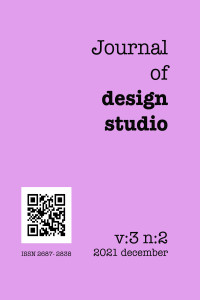Using a Brand Identity-Focused Project Structure to Improve the Competencies of Product Design Students
Abstract
It is essential to reflect the strategic connotations of the brand on the products while creating and developing a product design that fits the brand identity. Therefore, for a company, it is a critical issue to place the right messages that support the strategic brand identity in the design elements. From the designers' point of view, they are expected to have design skills such as analyzing a brand's uniqueness and brand knowledge and reflecting the results of these analyses on the product's aesthetics, function, and overall meaning. For this reason, as a part of the Industrial Design curriculum, brand identity focused product design has been restructured in Atılım University, Industrial Design program. In this studio course, the aim was for design students to acquire skills of brand identity and product identity analysis and basic design knowledge and skills. During 16 weeks, the data were collected by participant observation and conducting semi-structured interviews with the course students. The data gathered from the semi-structured interviews and participant observation were analyzed by using an inductive coding approach. Thus, product design suggestions that were suitable for the brand's identity were analyzed with the questions asked by the instructors during the design process. The results show that the questions asked by the instructors and the examples they gave let the students research, think, question, understand and make sense of the importance of information. As a result, the students obtained design outputs suitable for brand identity.
Keywords
Design Education Product Design Education Product Design Brand Identity Analysis of Brand Identity
References
- Demirbilek, O. (2004). Motivating students in research oriented courses in industrial design. In DS 33: Proceedings of E&PDE 2004, the 7th International Conference on Engineering and Product Design Education, Delft, the Netherlands, 02.-03.09. 2004 (pp. 399-407).
- Egan, A. (2021). Understanding Aesthetics in Design Education. In DS 110: Proceedings of the 23rd International Conference on Engineering and Product Design Education (E&PDE 2021), VIA Design, VIA University in Herning, Denmark. 9th-10th September 2021.
- Frascara, J. (2020). Design Education, Training, and the Broad Picture: Eight Experts Respond to a Few Questions. She Ji: The Journal of Design, Economics, and Innovation, 6(1), 106-117.
- Greenberg, D., Ehrensperger, E., Schulte-Mecklenbeck, M., Hoyer, W. D., Zhang, Z. J., & Krohmer, H. (2020). The role of brand prominence and extravagance of product design in luxury brand building: What drives consumers’ preferences for loud versus quiet luxury? Journal of Brand Management, 27(2), 195–210. https://doi.org/10.1057/s41262-019-00175-5
- Heitmann, M., Landwehr, J. R., Schreiner, T. F., & van Heerde, H. J. (2020). Leveraging Brand Equity for Effective Visual Product Design. Journal of Marketing Research, 57(2), 257–277. https://doi.org/10.1177/0022243720904004
- Homburg, C., Schwemmle, M., & Kuehnl, C. (2015). New product design: Concept, measurement, and consequences. Journal of Marketing, 79(3), 41–56. https://doi.org/10.1509/jm.14.0199
- Hsu, C. L., Chen, Y. C., Yang, T. N., Lin, W. K., & Liu, Y. H. (2018). Does product design matter? Exploring its influences in consumers’ psychological responses and brand loyalty. Information Technology and People, 31(3), 886–907. https://doi.org/10.1108/ITP-07-2017-0206
- Karjalainen, T. M., & Snelders, D. (2010). Designing visual recognition for the brand. Journal of Product Innovation Management, 27(1), 6-22.
- Karjalainen, T. M. (2003, June). Strategic design language–transforming brand identity into product design elements. In Proceedings of the 10th International Product Development Management Conference,(págs. 1-16). Brussels.
- Karjalainen, T. M. (2003, October). Strategic brand identity and symbolic design cues. In 6th Asian design conference (pp. 1-13).
- Kosinski, J., Bridges, J., Hedlund, G., & Wilde, O. (2011). Tron Legacy. Walt Disney Studios Home Entertainment.
- Kreuzbauer, R., & Malter, A. J. (2007). Product design perception and brand categorization. Advances in Consumer Research, 34, 240–246.
- Maurya, U. K., & Mishra, P. (2012). What is a brand? A Perspective on Brand Meaning. European Journal of Business and Management, 4(3), 122-133.
- Meyer, M. W., & Norman, D. (2020). Changing design education for the 21st century. She Ji: The Journal of Design, Economics, and Innovation, 6(1), 13-49.
- Mukherjee, S. K. (2021). Product Design with Form, Strength, and Function for Undergraduate Product Design Students—A Case Study. In Design for Tomorrow—Volume 2 (pp. 229-241). Springer, Singapore.
- Naletelich, K., & Spears, N. (2020). Analogical reasoning and regulatory focus: using the creative process to enhance consumer-brand outcomes within a co-creation context. European Journal of Marketing.
- Oswald, D. (2010). Towards a redefinition of product design and product design education. In DS 62: Proceedings of E&PDE 2010, the 12th International Conference on Engineering and Product Design Education-When Design Education and Design Research meet..., Trondheim, Norway, 02.-03.09. 2010.
- Page, C., & Herr, P. M. (2002). An investigation of the processes by which product design and brand strength interact to determine initial affect and quality judgments. Journal of Consumer Psychology, 12(2), 133–147. https://doi.org/10.1207/153276602760078668
- Parmentier, D. D., Van Acker, B. B., Saldien, J., & Detand, J. (2021). A framework to design for meaning: insights on use, practicality and added value within a project-based learning context. International Journal of Technology and Design Education, 31(4), 815-838
- Redström, J. (2020). Certain uncertainties and the design of design education. She Ji: The Journal of Design, Economics, and Innovation, 6(1), 83-100.
- Slade-Brooking, C. (2016). Creating a brand identity: a guide for designers. Hachette UK.
- Stompff, G. (2010). The forgotten bond: Brand identity and product design. Design Management Journal (Former Series), 14(1), 26–32. https://doi.org/10.1111/j.1948-7169.2003.tb00336.x
- Swanson, G. (2020). Educating the Designer of 2025. She Ji: The Journal of Design, Economics, and Innovation, 6(1), 101-105.
- Wang, H. X., Chen, J., Hu, Y. C., & Ye, M. (2008). The consistency of product design and brand image. 9th International Conference on Computer-Aided Industrial Design and Conceptual Design: Multicultural Creation and Design - CAIDCD 2008, 1142–1144. https://doi.org/10.1109/CAIDCD.2008.4730764
- Warell, A. (2015). Identity references in product design: An approach for inter-relating visual product experience and brand value representation. Procedia Manufacturing, 3, 2118-2125.
Abstract
Thanks
Çalışmamıza katılmayı kabül eden tüm öğrencilerimize çok teşekkür ederiz.
References
- Demirbilek, O. (2004). Motivating students in research oriented courses in industrial design. In DS 33: Proceedings of E&PDE 2004, the 7th International Conference on Engineering and Product Design Education, Delft, the Netherlands, 02.-03.09. 2004 (pp. 399-407).
- Egan, A. (2021). Understanding Aesthetics in Design Education. In DS 110: Proceedings of the 23rd International Conference on Engineering and Product Design Education (E&PDE 2021), VIA Design, VIA University in Herning, Denmark. 9th-10th September 2021.
- Frascara, J. (2020). Design Education, Training, and the Broad Picture: Eight Experts Respond to a Few Questions. She Ji: The Journal of Design, Economics, and Innovation, 6(1), 106-117.
- Greenberg, D., Ehrensperger, E., Schulte-Mecklenbeck, M., Hoyer, W. D., Zhang, Z. J., & Krohmer, H. (2020). The role of brand prominence and extravagance of product design in luxury brand building: What drives consumers’ preferences for loud versus quiet luxury? Journal of Brand Management, 27(2), 195–210. https://doi.org/10.1057/s41262-019-00175-5
- Heitmann, M., Landwehr, J. R., Schreiner, T. F., & van Heerde, H. J. (2020). Leveraging Brand Equity for Effective Visual Product Design. Journal of Marketing Research, 57(2), 257–277. https://doi.org/10.1177/0022243720904004
- Homburg, C., Schwemmle, M., & Kuehnl, C. (2015). New product design: Concept, measurement, and consequences. Journal of Marketing, 79(3), 41–56. https://doi.org/10.1509/jm.14.0199
- Hsu, C. L., Chen, Y. C., Yang, T. N., Lin, W. K., & Liu, Y. H. (2018). Does product design matter? Exploring its influences in consumers’ psychological responses and brand loyalty. Information Technology and People, 31(3), 886–907. https://doi.org/10.1108/ITP-07-2017-0206
- Karjalainen, T. M., & Snelders, D. (2010). Designing visual recognition for the brand. Journal of Product Innovation Management, 27(1), 6-22.
- Karjalainen, T. M. (2003, June). Strategic design language–transforming brand identity into product design elements. In Proceedings of the 10th International Product Development Management Conference,(págs. 1-16). Brussels.
- Karjalainen, T. M. (2003, October). Strategic brand identity and symbolic design cues. In 6th Asian design conference (pp. 1-13).
- Kosinski, J., Bridges, J., Hedlund, G., & Wilde, O. (2011). Tron Legacy. Walt Disney Studios Home Entertainment.
- Kreuzbauer, R., & Malter, A. J. (2007). Product design perception and brand categorization. Advances in Consumer Research, 34, 240–246.
- Maurya, U. K., & Mishra, P. (2012). What is a brand? A Perspective on Brand Meaning. European Journal of Business and Management, 4(3), 122-133.
- Meyer, M. W., & Norman, D. (2020). Changing design education for the 21st century. She Ji: The Journal of Design, Economics, and Innovation, 6(1), 13-49.
- Mukherjee, S. K. (2021). Product Design with Form, Strength, and Function for Undergraduate Product Design Students—A Case Study. In Design for Tomorrow—Volume 2 (pp. 229-241). Springer, Singapore.
- Naletelich, K., & Spears, N. (2020). Analogical reasoning and regulatory focus: using the creative process to enhance consumer-brand outcomes within a co-creation context. European Journal of Marketing.
- Oswald, D. (2010). Towards a redefinition of product design and product design education. In DS 62: Proceedings of E&PDE 2010, the 12th International Conference on Engineering and Product Design Education-When Design Education and Design Research meet..., Trondheim, Norway, 02.-03.09. 2010.
- Page, C., & Herr, P. M. (2002). An investigation of the processes by which product design and brand strength interact to determine initial affect and quality judgments. Journal of Consumer Psychology, 12(2), 133–147. https://doi.org/10.1207/153276602760078668
- Parmentier, D. D., Van Acker, B. B., Saldien, J., & Detand, J. (2021). A framework to design for meaning: insights on use, practicality and added value within a project-based learning context. International Journal of Technology and Design Education, 31(4), 815-838
- Redström, J. (2020). Certain uncertainties and the design of design education. She Ji: The Journal of Design, Economics, and Innovation, 6(1), 83-100.
- Slade-Brooking, C. (2016). Creating a brand identity: a guide for designers. Hachette UK.
- Stompff, G. (2010). The forgotten bond: Brand identity and product design. Design Management Journal (Former Series), 14(1), 26–32. https://doi.org/10.1111/j.1948-7169.2003.tb00336.x
- Swanson, G. (2020). Educating the Designer of 2025. She Ji: The Journal of Design, Economics, and Innovation, 6(1), 101-105.
- Wang, H. X., Chen, J., Hu, Y. C., & Ye, M. (2008). The consistency of product design and brand image. 9th International Conference on Computer-Aided Industrial Design and Conceptual Design: Multicultural Creation and Design - CAIDCD 2008, 1142–1144. https://doi.org/10.1109/CAIDCD.2008.4730764
- Warell, A. (2015). Identity references in product design: An approach for inter-relating visual product experience and brand value representation. Procedia Manufacturing, 3, 2118-2125.
Details
| Primary Language | English |
|---|---|
| Subjects | Architecture |
| Journal Section | Research Articles |
| Authors | |
| Publication Date | December 30, 2021 |
| Published in Issue | Year 2021 Volume: 3 Issue: 2 |
This work is licensed under a Creative Commons Attribution 4.0 International License.

The articles published in Journal of Design Studio had been similarity checked by Turnitin.
CALL FOR ARTICLES
Journal of Design Studio call for research papers on studios in all disciplines. Please submit your article by using Dergipark online submission system.



